Is it possible to freeze pumpkin while retaining maximum beneficial properties: let’s explore all possible options and choose the best one
Pumpkin is a dietary product rich in vitamins and microelements. The benefits of this vegetable are difficult to overestimate. Some late varieties are stored in a cellar or apartment until spring. Well, freezing will help preserve this vegetable until the next harvest. What methods of freezing, storing and using this product exist, read our article.
Is it possible to freeze pumpkin for the winter?
Not everyone knows that “orange beauty” can be frozen. There is an opinion that after defrosting, the vegetable acquires a “rubbery” taste, becomes watery and unsuitable for food. Yes, this happens if you freeze the product incorrectly.
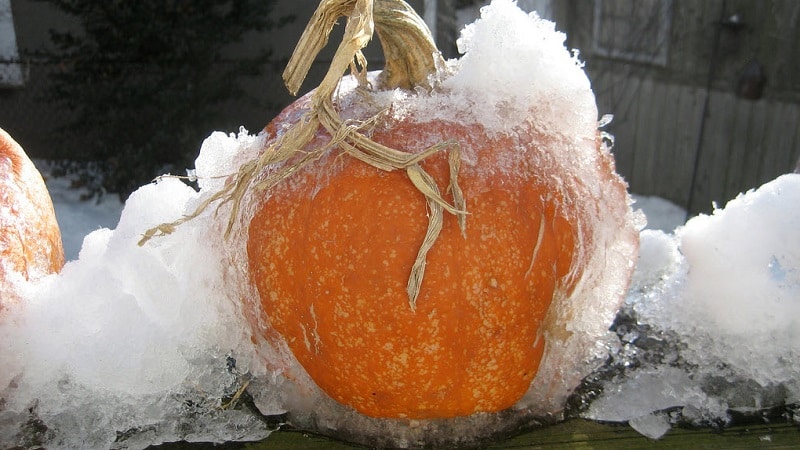
Semi-finished pumpkin products retain almost all their beneficial properties and are in no way inferior to fresh vegetables. Most dishes can be prepared from frozen pumpkin. At the same time, the cooking process becomes easier and faster.
The only drawback of this storage method is that frozen pumpkin takes up a lot of space in the refrigerator. But if you have a large freezer, this minus will not exist.
Below we will tell you how to properly freeze vegetables for preservation. not only beneficial properties, but also taste. Let's start by preparing the product for freezing.
Preparing for freezing
To freeze for the winter, choose fruit that is not overripe.. Cut pieces left in the refrigerator will not work - only whole vegetables. Make sure that the pumpkin tail is not rotten.
Preparing a vegetable for freezing involves washing and peeling it.:
- First of all, the pumpkin is thoroughly washed under running water. This can also be done with special liquid soap for fruits and vegetables.
- The vegetable is cut into two parts and the fibers along with the seeds are scraped out. Only the hard part is suitable for freezing.
Attention! Pumpkin seeds are not thrown away. They are used both for planting the next crop and for eating. The seeds contain a huge amount of microelements and amino acids that are beneficial to the human body.
Freezing options
Pumpkin can be frozen both fresh and after preliminary heat treatment.. Let's talk about each option in detail.
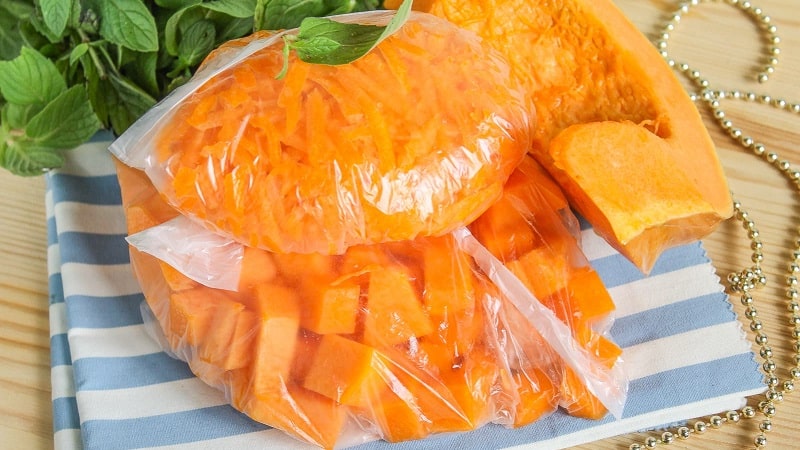
Divided into large parts
This is the easiest and fastest option for freezing pumpkin.. Peeled and dried with a paper towel, the vegetable is cut into slices/sticks ranging in size from 2-3 cm in width and up to 10 cm in length. The pieces are laid out on a baking sheet or board and, covered with cling film on top, placed in the freezer for 2-3 hours. Then the frozen blocks are transferred to a container or bags and put back for further storage.
Attention! Pumpkin frozen in this way, after defrosting, is used for preparing pureed soups, porridges, stewing with meat and preparing side dishes.
Cut into small pieces/cubes
The technology is the same as in the previous version. Only the size and shape are selected depending on further use.
As a puree
Pumpkin is cut into cubes 2-3 cm in size. To prepare the puree, the vegetable is boiled or baked in the oven, slow cooker or microwave. When it becomes soft, use a blender or fork to bring it to a mushy mass.And after complete cooling, they are packaged in bags or containers and sent to the freezer.
Advice! If you are freezing pumpkin for baby feeding, it is better to package the vegetable puree in small molds. Ice trays are ideal.
Shredded
Pumpkin frozen this way is great for making pancakes and pies.. Fresh vegetables grated on a coarse grater are placed in bags and frozen. Preliminary heat treatment is not required in this case.
Boiled
Boiled pumpkin is not only stored in the freezer for 1-2 months longer than fresh, but also does not lose its taste and color at all. You can cook the vegetable with the peel - it can be easily removed after cooking.
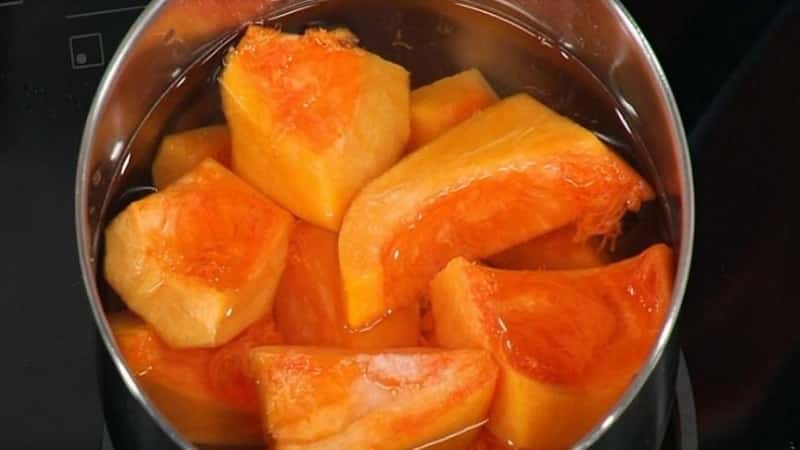
You can cook pumpkin on the stove:
- Large pumpkin slices are placed in boiling water and boiled until tender for 10-15 minutes.
- Place the finished vegetable in a colander to drain the water.
- Cool and place in containers in the freezer. But most often, cooked pumpkin is pureed and frozen in this form.
Advice! Boil and steam the pumpkin - then more vitamins are retained in the vegetable. The microwave oven speeds up the cooking process.
Baked
The vegetable is baked in large, unpeeled slices or peeled small cubes. Cooking time depends on the size of the pieces, maximum 40 minutes at 180° C.
Baked pumpkin, just like boiled pumpkin, is most often frozen in the form of puree.. But you can store it in the freezer in small cubes. In this case, place the cooled pumpkin on a baking sheet or board, cover with cling film and place in the freezer for a day. Only the next day the cubes are poured into a bag for further storage.
Read also:
Blanched
Vegetables prepared for freezing using this method, even after complete defrosting they will not be watery. Preparing for freezing blanched pumpkin is the same as for freezing fresh pumpkin pieces. Only after drying, the vegetable cubes are placed in a colander and dipped in boiling water for 2-3 minutes. After this, immediately place it in cold water. Then let the pumpkin pieces dry again, place them on a baking sheet and place them in the freezer. After 1-2 hours, the workpiece is packed into bags and sent back for long-term storage.
In a vacuum
The product can also be frozen using a vacuum sealer.. To do this, the vegetable is cut into large cubes/slices and placed in special bags for this device. In a vacuum, the workpiece is stored even longer than in conventional containers.
Storage conditions and periods
Frozen pumpkin should be stored in tight bags. for freezing or in an airtight container. Ideally, set aside a separate drawer for storing vegetables in the freezer. Then the preparations will definitely not be saturated with the odors of raw meat and fish. Pumpkin frozen in the freezer at a temperature of -18° C and below can be stored for up to 10-12 months.
Further use
Frozen pumpkin is used for cooking porridges, soups, first and second courses, salads, sauces and a variety of baked goods. Desserts are prepared from the orange vegetable and jelly is cooked. It perfectly complements meat dishes. And for children's complementary foods it is simply irreplaceable - it contains many vitamins and microelements that are beneficial for the growth and development of the baby.
Grated pumpkin, without defrosting, is added to almost ready-made dishes, make pancakes out of it.When baked, it perfectly complements porridges and side dishes, where it is also added at the end of cooking/frying. Any dish with a bright, juicy vegetable will be not only healthy, but also festive.
For baby feeding
Pumpkin for complementary feeding is frozen separately, and as part of a vegetable mixture. In baby food it is combined with zucchini, broccoli and carrots. The mixture can be frozen as a puree or in small cubes.
With carrots and zucchini
Puree prepared according to this recipe is ideal for baby feeding. It is enough to simply heat up such a preparation.
Ingredients:
- pumpkin;
- zucchini;
- carrot.
All ingredients are taken in equal proportions.
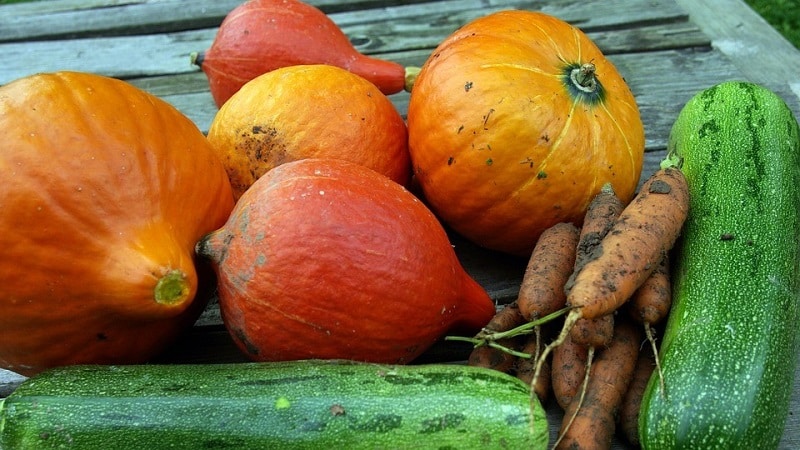
Cooking process:
- All vegetables are washed and peeled.
- The pumpkin is cut into large slices, the zucchini is cut into two halves.
- The vegetables are placed in an oven heated to 180°C and baked for about 40 minutes.
- Cool, separate the pulp from the pumpkin and zucchini, mix and puree.
- The vegetable puree is laid out in portions into bags (yogurt cups are also suitable) and sent for freezing.
For baking
Pies, pancakes, pancakes, cookies will become even tastier and more aromatic with orange vegetables. Pumpkin makes a variety of casseroles.
Casserole
This aromatic dish will appeal even to those who do not like pumpkin in its pure form. It is suitable for both breakfast and dinner.
Ingredients:
- frozen pumpkin – 0.5 kg;
- apples – 200 g;
- chicken eggs – 2-3 pcs.;
- semolina – 100 g;
- butter – 150 g;
- granulated sugar – 1 tbsp. l.;
- soda - on the tip of a knife;
- salt - to taste.
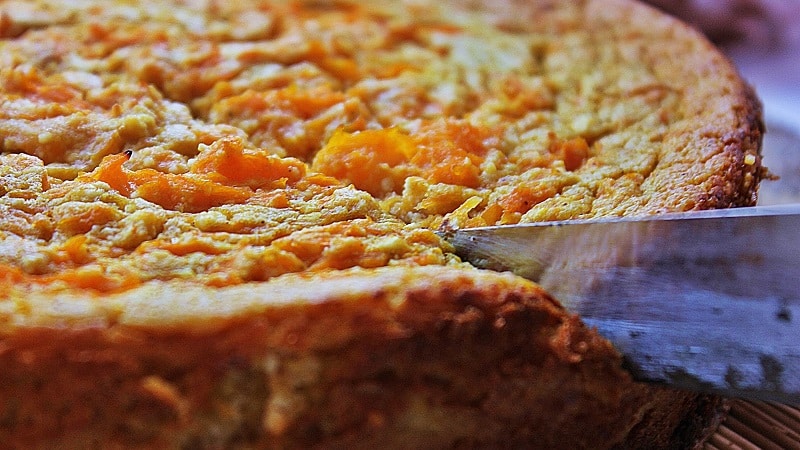
Cooking process:
- For this dish, pumpkin is suitable, frozen in the form of puree, cubes or baked. If the pumpkin is raw, boil it until tender, puree and cool.In other cases, the vegetable is simply defrosted and the excess liquid is drained or added without defrosting to the rest of the ingredients.
- Grated apples, semolina, butter and soda are added to the pumpkin puree. All ingredients are mixed.
- The resulting mixture is poured with eggs beaten with sugar and placed in a baking dish, greased or covered with parchment paper.
- Bake the pumpkin casserole in the oven at 200°C for about half an hour. The exact cooking time depends on the oven.
It can be useful:
For first and second courses
For preparing most hot dishes Frozen pumpkin preparations do not even require special defrosting. The pieces are simply placed in boiling water, broth or milk and brought to readiness.
Cream soup
This simple vitamin soup will appeal to many people.. And adding fried bacon or croutons to it can make it more satisfying.
Ingredients:
- frozen pumpkin pieces – 0.5 kg;
- potatoes – 5 pcs.;
- onion – 1 pc.;
- carrots – 1 pc.;
- cream 10-20% fat – 0.5 l;
- spices (salt, pepper, garlic, ginger, nutmeg) - to taste;
- greens - for serving;
- croutons and bacon - optional.
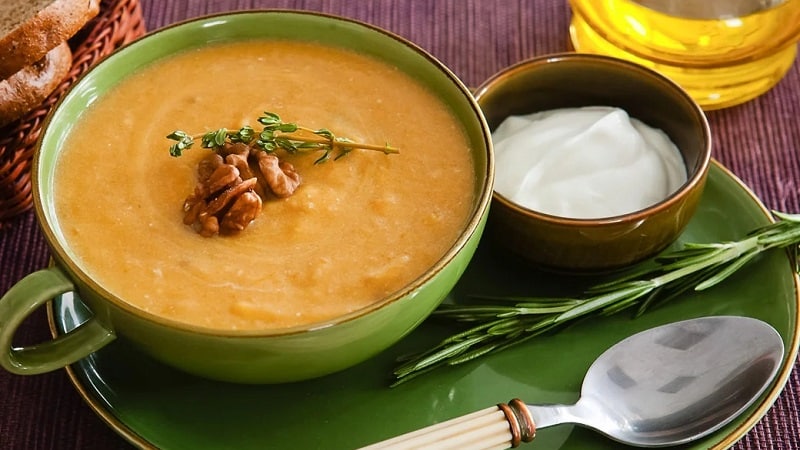
Cooking process:
- Peeled vegetables are cut into pieces of arbitrary shape. Frozen pumpkin cubes do not need to be thawed first.
- Place the vegetables in a saucepan and add water so that it completely covers all the vegetables. Bring to a boil and cook over low heat until tender (until all vegetables are soft).
- The water is drained and the boiled vegetables are pureed with a blender, masher or fork.
- Spices are added to the resulting vegetable mass, mixed thoroughly and heated cream is added.
- The bacon is cut into thin strips and fried over high heat.
- If desired, crackers are made as follows: cut the bread into cubes, sprinkle with spices and sprinkle with oil. In the oven at 180-200°C they will be ready in 15 minutes.
- Serve cream soup garnished with green onions or parsley. Bacon and croutons are added to the plate just before serving.
How to properly defrost before use
The defrosting process directly depends on the method of freezing and further use of the product. There are several ways:
- Pumpkin puree is defrosted in the refrigerator on the bottom shelf or in the microwave.
- For preparing porridge or stew Do not defrost first. When frozen, it is placed in boiling water or milk, and then the rest of the ingredients are laid out.
- Grated pumpkin is also added without prior defrosting shortly before the end of cooking.
Important! Once thawed, a product cannot be re-frozen. Therefore, vegetables should be packaged in portions so that there is no excess left.
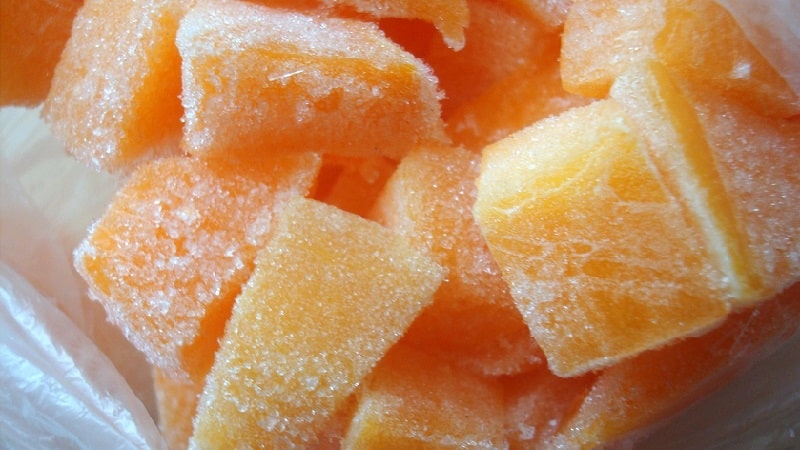
Tips and tricks
To get the most out of frozen vegetables, there are a few tricks you should know. Follow these guidelines, and you will succeed:
- Not all varieties of pumpkin are suitable for freezing.. It is preferable to take elongated vegetables with bright pulp for these purposes. The best varieties are considered to be Butternut, Muscatnaya, Divo, Harlequin, Acorn, Gribovskaya, Gileya, Khersonskaya, Bylinka. Light, early varieties do not tolerate low temperatures.
- Choose a pumpkin without defects on the skin. If the fruit begins to rot, then even at sub-zero temperatures it will continue to deteriorate.After harvesting, the pumpkin should be kept for a week at room temperature or in a dry cellar. This will remove excess moisture and prepare it for long-term storage.
- So that after defrosting pumpkin frozen raw was not watery; before freezing, it is blanched in boiling water (3-4 minutes) or dried in the oven (5-10 minutes).
- The most compact storage option frozen pumpkin - puree in bags, laid out in layers.
- The benefits of pumpkin dishes can be increasedby adding butter or milk. Beta-carotene contained in vegetables is better absorbed with vegetable or animal fats. But this should be done already during the cooking process.
- To get rid of excess moisture When frying frozen pumpkin, first salt it and leave for 1-2 hours. After this, all that remains is to blot the vegetable with a paper towel.
Conclusion
When frozen, pumpkin does not lose its beneficial properties. The main thing is to correctly select the fruits suitable for harvesting. There are many options for freezing this vegetable; every housewife will find one convenient for herself, depending on the subsequent use.
Frozen pumpkin is used in preparing a variety of dishes, including baby food.